A Study of Natural Radioactivity Levels and Radon/Thoron Release Potential of Bedrock and Soil in Southeastern Ireland
Abstract
1. Introduction
2. Materials and Methods
2.1. Geological Setting and Soils of the Study Area
2.2. Collection and Management of Available Data
2.2.1. Indoor Radon Data
2.2.2. Airborne Radiometric Survey
2.2.3. Geochemistry of Stream Sediment Samples
2.3. Measurements and Instruments
Ambient Dose Rate (ADR) Mapping and 222Rn/220Rn Exhalation Rates
3. Results
3.1. Grouping Based on Geological Bedrock Borders
3.2. Grouping Based on Soil Type Variations
3.3. Estimation of Annual Effective Dose Rate and Radon Release Potential Based on Airborne Radiometrics
4. Discussion
5. Conclusions
Author Contributions
Funding
Institutional Review Board Statement
Informed Consent Statement
Data Availability Statement
Acknowledgments
Conflicts of Interest
References
- United Nations Scientific Committee on the Effects of Atomic Radiation. Effects of Ionizing Radiation: Report to the General Assembly, with Scientific Annexes; United Nations Publications: Hong Kong, China, 2008; Volume 1. [Google Scholar]
- Vogiannis, E.G.; Nikolopoulos, D. Radon sources and associated risk in terms of exposure and dose. Front. Public Health 2015, 2, 207. [Google Scholar] [CrossRef]
- Giustini, F.; Ciotoli, G.; Rinaldini, A.; Ruggiero, L.; Voltaggio, M. Mapping the geogenic radon potential and radon risk by using Empirical Bayesian Kriging regression: A case study from a volcanic area of central Italy. Sci. Total Environ. 2019, 661, 449–464. [Google Scholar] [CrossRef]
- Baskaran, M. Radon: A Tracer for Geological, Geophysical and Geochemical Studies; Springer International Publishing: Berlin/Heidelberg, Germany, 2016. [Google Scholar]
- Ciotoli, G.; Voltaggio, M.; Tuccimei, P.; Soligo, M.; Pasculli, A.; Beaubien, S.; Bigi, S. Geographically weighted regression and geostatistical techniques to construct the geogenic radon potential map of the Lazio region: A methodological proposal for the European Atlas of Natural Radiation. J. Environ. Radioact. 2017, 166, 355–375. [Google Scholar] [CrossRef]
- Pantelić, G.; Eliković, I.; Živanović, M.; Vukanac, I.; Nikolić, J.; Cinelli, G.; Gruber, V. Literature Review of Indoor Radon Surveys in Europe; JRC114370; Publications Office of the European Union: Luxembourg, 2018. [Google Scholar]
- Scheib, C.; Appleton, J.D.; Miles, J.C.H.; Green, B.M.R.; Barlow, T.S.; Jones, D.G. Geological controls on radon potential in Scotland. Scott. J. Geol. 2009, 45, 147–160. [Google Scholar] [CrossRef]
- Gruber, V.; Bossew, P.; De Cort, M.; Tollefsen, T. The European map of the geogenic radon potential. J. Radiol. Prot. 2013, 33, 51–60. [Google Scholar] [CrossRef] [PubMed]
- Pásztor, L.; Szabó, K.Z.; Szatmári, G.; Laborczi, A.; Horváth, Á. Mapping geogenic radon potential by regression kriging. Sci. Total Environ. 2016, 544, 883–891. [Google Scholar] [CrossRef] [PubMed]
- Bossew, P.; Cinelli, G.; Ciotoli, G.; Crowley, Q.G.; De Cort, M.; Medina, J.E.; Gruber, V.; Petermann, E.; Tollefsen, T. Development of a Geogenic Radon Hazard Index—Concept, History, Experiences. Int. J. Environ. Res. Public Health 2020, 17, 4134. [Google Scholar] [CrossRef]
- Yarmoshenko, I.V.; Vasilyev, A.; Malinovsky, G.; Bossew, P.; Žunić, Z.; Onischenko, A.; Zhukovsky, M. Variance of indoor radon concentration: Major influencing factors. Sci. Total Environ. 2016, 541, 155–160. [Google Scholar] [CrossRef]
- Kemski, J.; Klingel, R.; Siehl, A.; Valdivia-Manchego, M. From radon hazard to risk prediction-based on geological maps, soil gas and indoor measurements in Germany. Environ. Earth Sci. 2008, 56, 1269–1279. [Google Scholar] [CrossRef]
- Smethurst, M.; Watson, R.; Baranwal, V.; Rudjord, A.; Finne, I. The predictive power of airborne gamma ray survey data on the locations of domestic radon hazards in Norway: A strong case for utilizing airborne data in large-scale radon potential mapping. J. Environ. Radioact. 2017, 166, 321–340. [Google Scholar] [CrossRef] [PubMed]
- Tedd, K.; Misstear, B.; Coxon, C.; Daly, D.; Williams, T.H.; Craig, M.; Mannix, A. A Review of Groundwater Levels in the South-East of Ireland. Review of Groundwater Level Data in the South Eastern River Basin District. Environmental Research Centre Report; Environmental Protection Agency: Wexford, Ireland, 2011.
- Shannon, P.M. The Stratigraphy and Sedimentology of the Lower Palaeozoic Rocks of South-East County Wexford. Proceedings of the Royal Irish Academy. Section B: Biological, Geological, and Chemical Science; Royal Irish Academy: Dublin, Ireland, 1978; pp. 247–265. [Google Scholar]
- Conservation and Amenity Advice Service. Landscape Appraisal of County Kilkenny; CAAS Environmental Services Ltd.: Dublin, Ireland, 2003. [Google Scholar]
- Drolet, J.-P.; Martel, R.; Poulin, P.; Dessau, J.-C.; Lavoie, D.; Parent, M.; Lévesque, B. An approach to define potential radon emission level maps using indoor radon concentration measurements and radiogeochemical data positive proportion relationships. J. Environ. Radioact. 2013, 124, 57–67. [Google Scholar] [CrossRef] [PubMed]
- Appleton, J.; Miles, J.; Green, B.; Larmour, R. Pilot study of the application of Tellus airborne radiometric and soil geochemical data for radon mapping. J. Environ. Radioact. 2008, 99, 1687–1697. [Google Scholar] [CrossRef]
- Barnet, I. Radon in Geological Environment: Czech Experience; Czech Geological Survey: Brno, Czech Republic, 2008. [Google Scholar]
- Tondeur, F.; Cinelli, G.; Dehandschutter, B. Homogenity of geological units with respect to the radon risk in the Walloon region of Belgium. J. Environ. Radioact. 2014, 136, 140–151. [Google Scholar] [CrossRef]
- Hodgson, J.; Carey, S.; Scanlon, R. Developing a New National Radon Risk Map; Radiological Protection Institute: Dublin, Ireland, 2014. [Google Scholar]
- Burke, Ó.; Long, S.; Murphy, P.; Organo, C.; Fenton, D.; Colgan, P.A. Estimation of seasonal correction factors through Fourier decomposition analysis—A new model for indoor radon levels in Irish homes. J. Radiol. Prot. 2010, 30, 433–443. [Google Scholar] [CrossRef] [PubMed]
- Elío, J.; Crowley, Q.; Scanlon, R.; Hodgson, J.; Long, S. Logistic regression model for detecting radon prone areas in Ireland. Sci. Total Environ. 2017, 599–600, 1317–1329. [Google Scholar] [CrossRef]
- Hodgson, J.; Young, M. The Tellus airborne geophysical surveys and results. In Unearthed: Impact of the Tellus Surveys of the North of Ireland; Royal Irish Academy: Dublin, Ireland, 2016; pp. 11–32. [Google Scholar] [CrossRef]
- Airo, M. Regional interpretation of aerogeophysical data: Extracting compositional and structural features. Spec. Pap. Surv. Finl. 2005, 39, 176. [Google Scholar]
- Baldoncini, M.; Albéri, M.; Bottardi, C.; Minty, B.; Raptis, K.G.C.; Strati, V.; Mantovani, F. Airborne Gamma-Ray Spectroscopy for Modeling Cosmic Radiation and Effective Dose in the Lower Atmosphere. IEEE Trans. Geosci. Remote Sens. 2017, 56, 823–834. [Google Scholar] [CrossRef]
- Beamish, D.; White, J.C. A radiometric airborne geophysical survey of the Isle of Wight. Proc. Geol. Assoc. 2011, 122, 787–799. [Google Scholar] [CrossRef]
- Elío, J.; Crowley, Q.; Scanlon, R.; Hodgson, J.; Long, S.; Cooper, M.; Gallagher, V. Application of airborne radiometric surveys for large-scale geogenic radon potential classification. J. Eur. Radon Assoc. 2020. [Google Scholar] [CrossRef]
- Prajith, R.; Rout, R.P.; Kumbhar, D.; Mishra, R.; Sahoo, B.K.; Sapra, B.K. Measurements of radon (222Rn) and thoron (220Rn) exhalations and their decay product concentrations at Indian Stations in Antarctica. Environ. Earth Sci. 2019, 78, 35. [Google Scholar] [CrossRef]
- Ferreira, A.; Daraktchieva, Z.; Beamish, D.; Kirkwood, C.; Lister, T.R.; Cave, M.; Wragg, J.; Lee, K. Indoor radon measurements in south west England explained by topsoil and stream sediment geochemistry, airborne gamma-ray spectroscopy and geology. J. Environ. Radioact. 2018, 181, 152–171. [Google Scholar] [CrossRef]
- Young, M.; Knights, K.; Smyth, D.; Glennon, M.; Scanlon, R.; Gallagher, V. The Tellus geochemical surveys, results and applications. In Unearthed: Impacts of the Tellus Surveys of the North of Ireland. Royal Irish Academy; Royal Irish Academy: Dublin, Ireland, 2016; pp. 33–52. [Google Scholar]
- Kropat, G.; Bochud, F.; Murith, C.; Gruson, M.P.; Baechler, S. Modeling of geogenic radon in Switzerland based on ordered logistic regression. J. Environ. Radioact. 2017, 166, 376–381. [Google Scholar] [CrossRef]
- Neznal, M.; Neznal, M.; Matolin, M.; Barnet, I.; Miksova, J. The New Method for Assessing the Radon Risk of Building Sites. Czech Geological Survey; RADON: Prague, Czech Republic, 2004. [Google Scholar]
- Lucchetti, C.; Briganti, A.; Castelluccio, M.; Galli, G.; Santilli, S.; Soligo, M.; Tuccimei, P. Integrating radon and thoron flux data with gamma radiation mapping in radon-prone areas. The case of volcanic outcrops in a highly-urbanized city (Roma, Italy). J. Environ. Radioact. 2019, 202, 41–50. [Google Scholar] [CrossRef]
- United Nations Scientific Committee on the Effects of Atomic Radiation. Sources and Effects of Ionizing Radiation; United Nations: New York, NY, USA, 2000. [Google Scholar]
- Örgün, Y.; Altınsoy, N.; Gültekin, A.; Karahan, G.; Celebi, N. Natural radioactivity levels in granitic plutons and groundwaters in Southeast part of Eskisehir, Turkey. Appl. Radiat. Isot. 2005, 63, 267–275. [Google Scholar] [CrossRef]
- Valković, V. Radioactivity in the Environment; Elsevier Science B.V.: Amsterdam, The Netherlands, 2000. [Google Scholar]
- Tzortzis, M.; Tsertos, H. Determination of thorium, uranium and potassium elemental concentrations in surface soils in Cyprus. J. Environ. Radioact. 2004, 77, 325–338. [Google Scholar] [CrossRef] [PubMed]
- Hurley, B.W. Natural Radioactivity in the Geologic Environment; National Nuclear Security Administration, Nevada Site Office: North Las Vegas, NV, USA, 2009.
- Erdi-Krausz, G.; Matolin, M.; Minty, B.; Nicolet, J. Guidelines for Radioelement Mapping Using Gamma Ray Spectrometry Data: Also as Open Access E-Book; International Atomic Energy Agency: Vienna, Austria, 2003. [Google Scholar]
- Schön, J. Physical Properties of Rocks: Fundamentals and Principles of Petrophysics; Elsevier: Amsterdam, The Netherlands, 2015. [Google Scholar]
- Wattananikorn, K.; Emharuthai, S.; Wanaphongse, P. A feasibility study of geogenic indoor radon mapping from airborne radiometric survey in northern Thailand. Radiat. Meas. 2008, 43, 85–90. [Google Scholar] [CrossRef]
- Friedmann, H.; Baumgartner, A.; Bernreiter, M.; Gräser, J.; Gruber, V.; Kabrt, F.; Kaineder, H.; Maringer, F.; Ringer, W.; Seidel, C.; et al. Indoor radon, geogenic radon surrogates and geology—Investigations on their correlation. J. Environ. Radioact. 2017, 166, 382–389. [Google Scholar] [CrossRef]
- The 2007 Recommendations of the International Commission on Radiological Protection. ICRP publication 103. Ann. ICRP 2007, 37, 1–332. [CrossRef]
- Elío, J.; Crowley, Q.; Scanlon, R.; Hodgson, J.; Zgaga, L. Estimation of residential radon exposure and definition of Radon Priority Areas based on expected lung cancer incidence. Environ. Int. 2018, 114, 69–76. [Google Scholar] [CrossRef] [PubMed]
- O’Connor, C.; Currivan, L.; Cunningham, N.; Kelleher, K. Radiation Doses Received by the Irish Population; Radiological Protection Institute of Ireland: Dublin, Ireland, 2014. [Google Scholar]
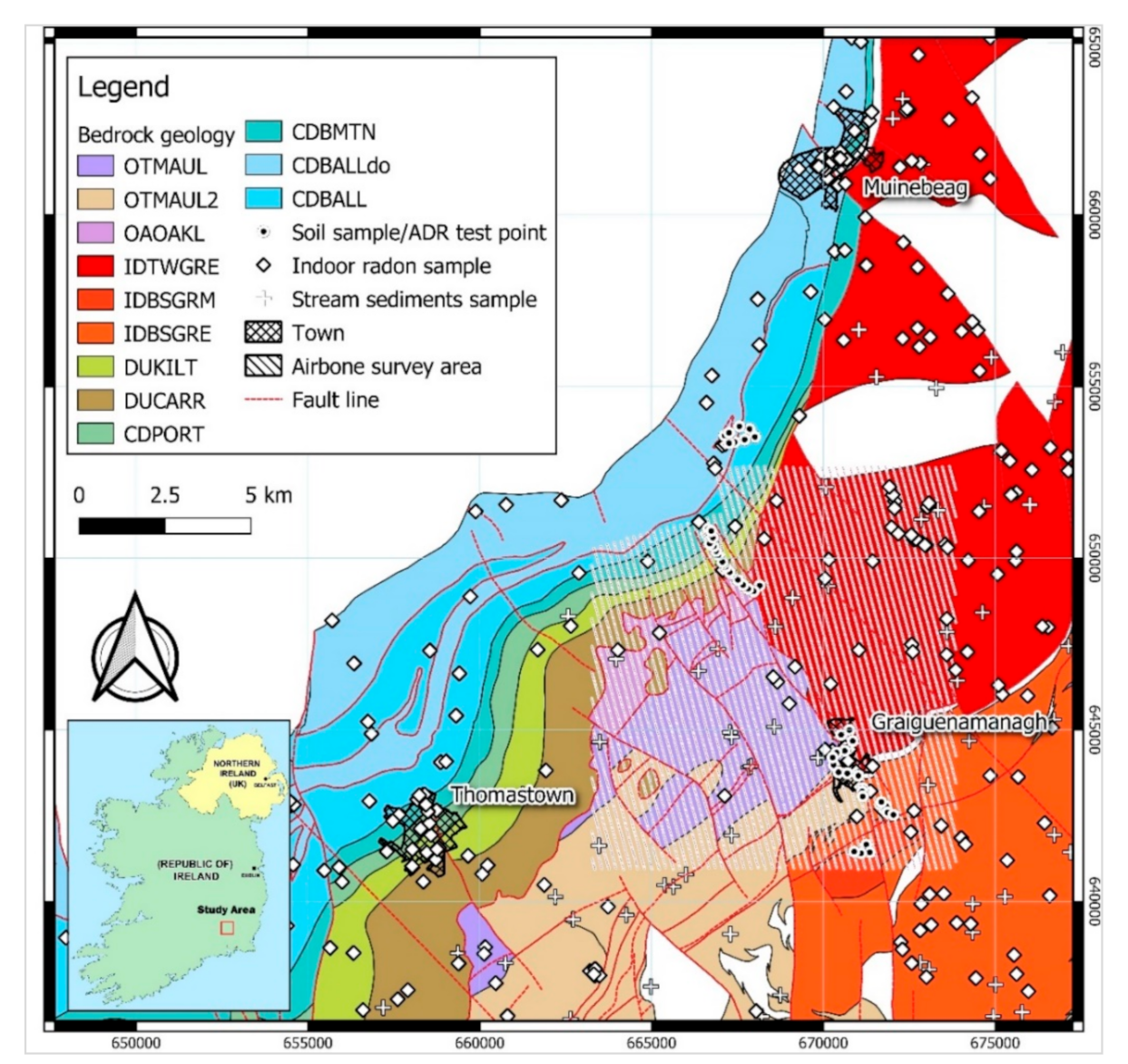
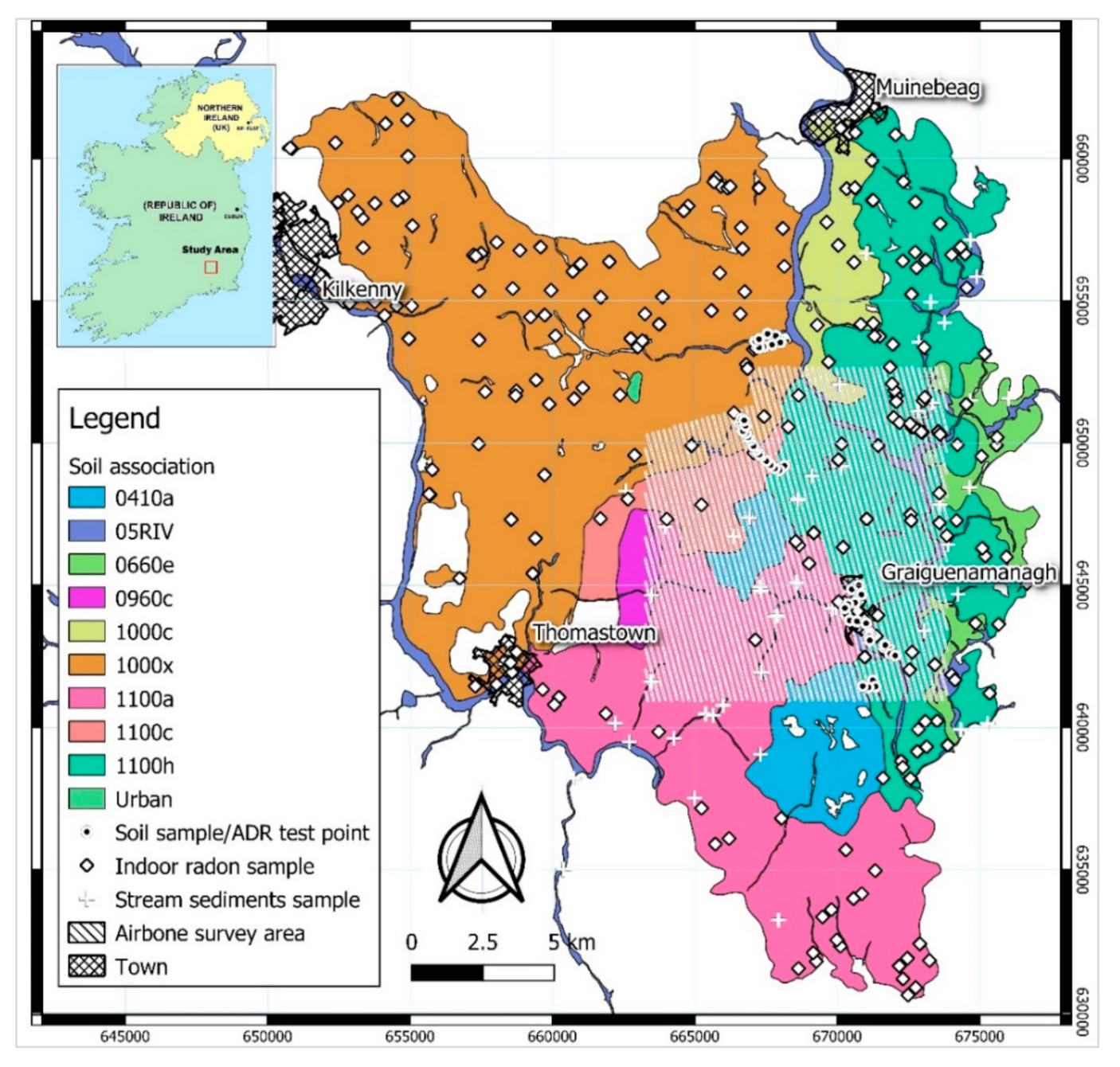

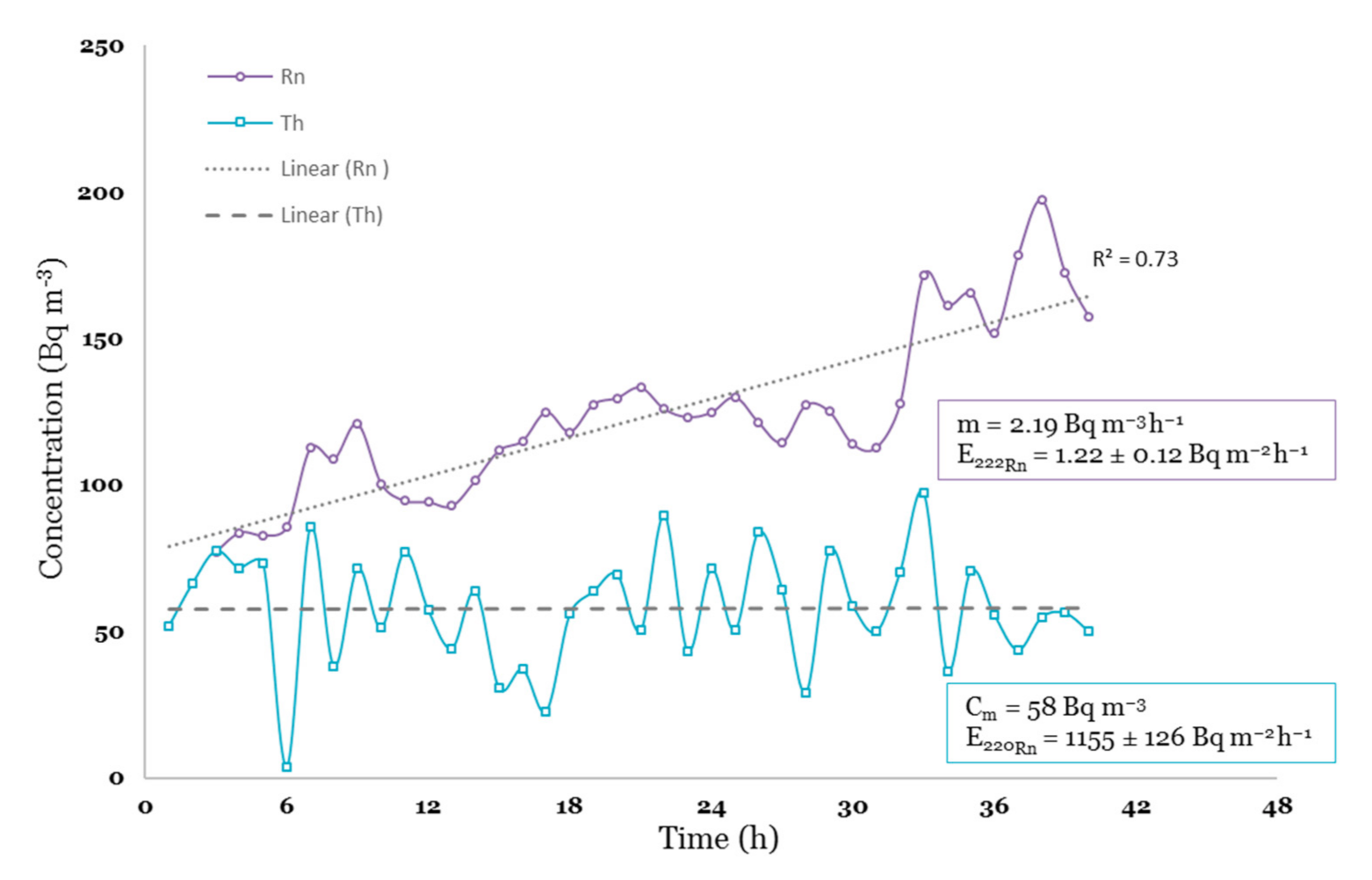
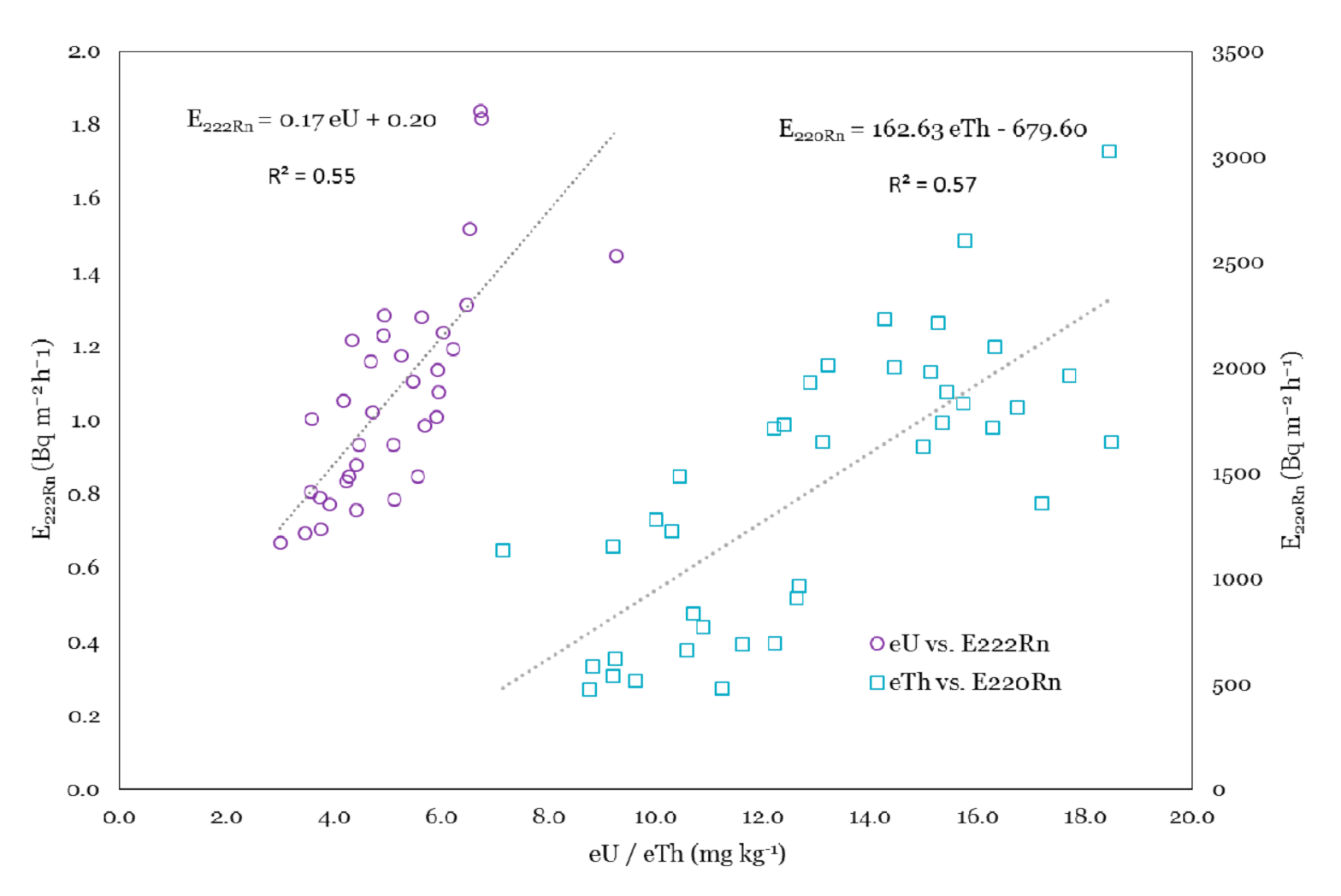
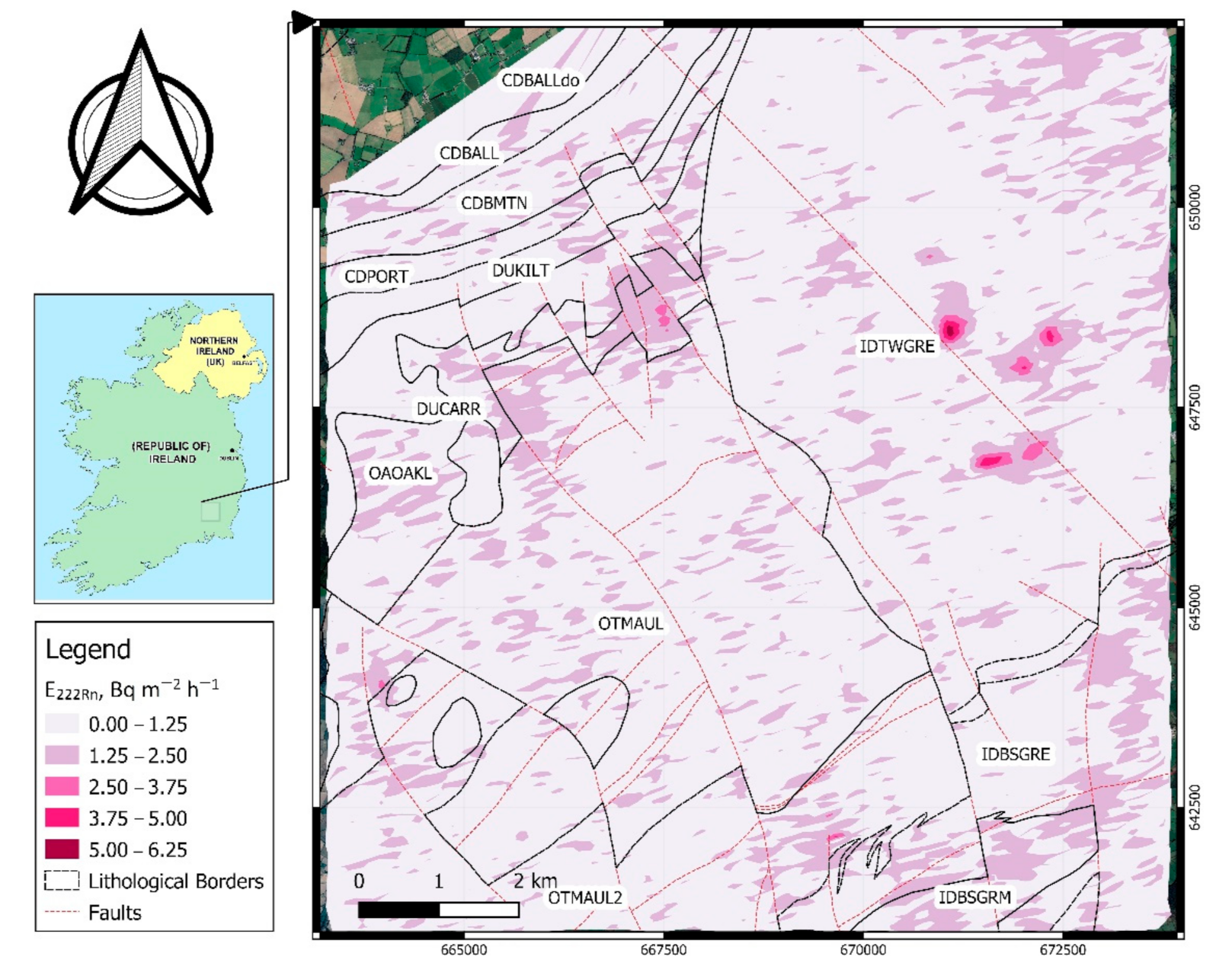
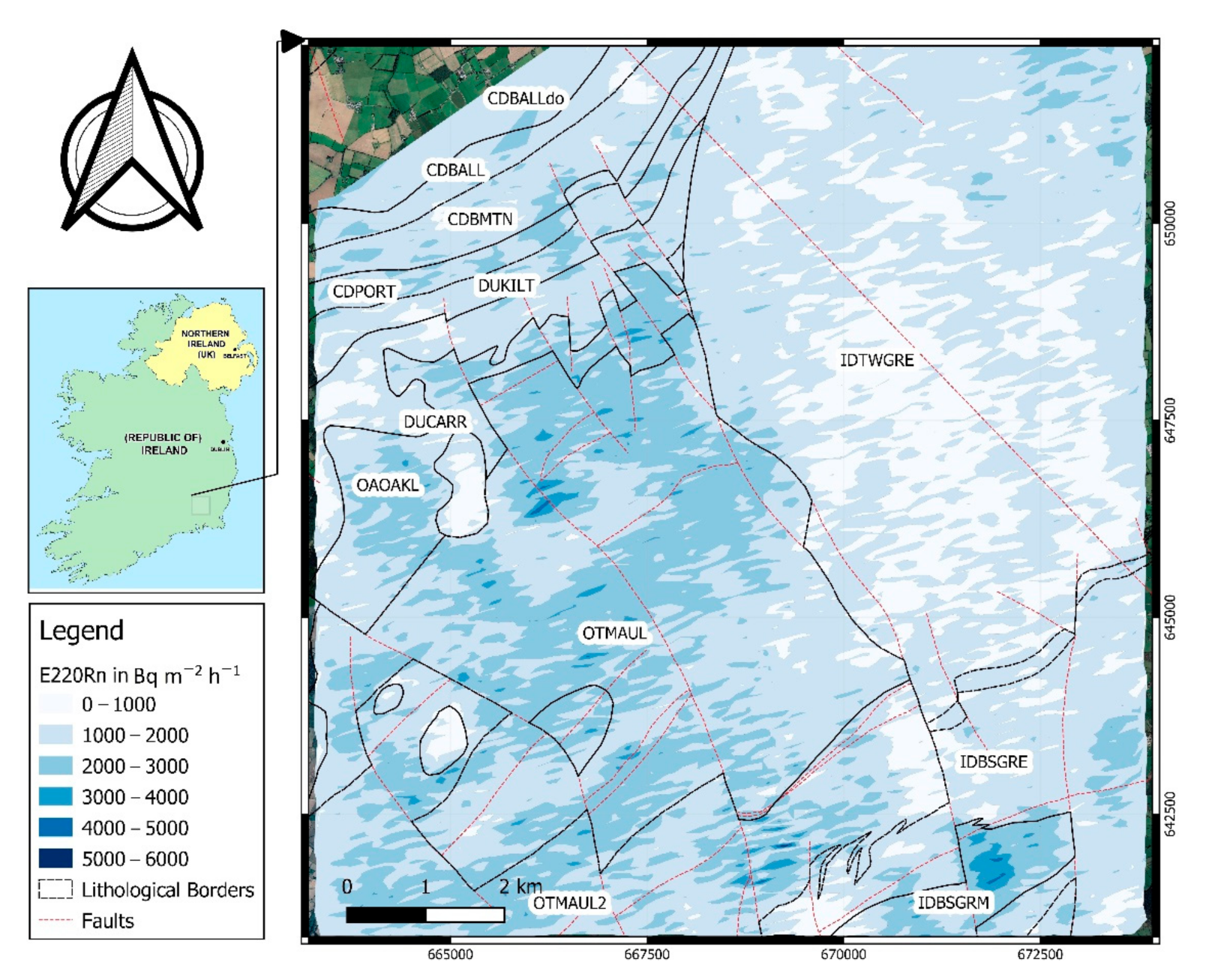
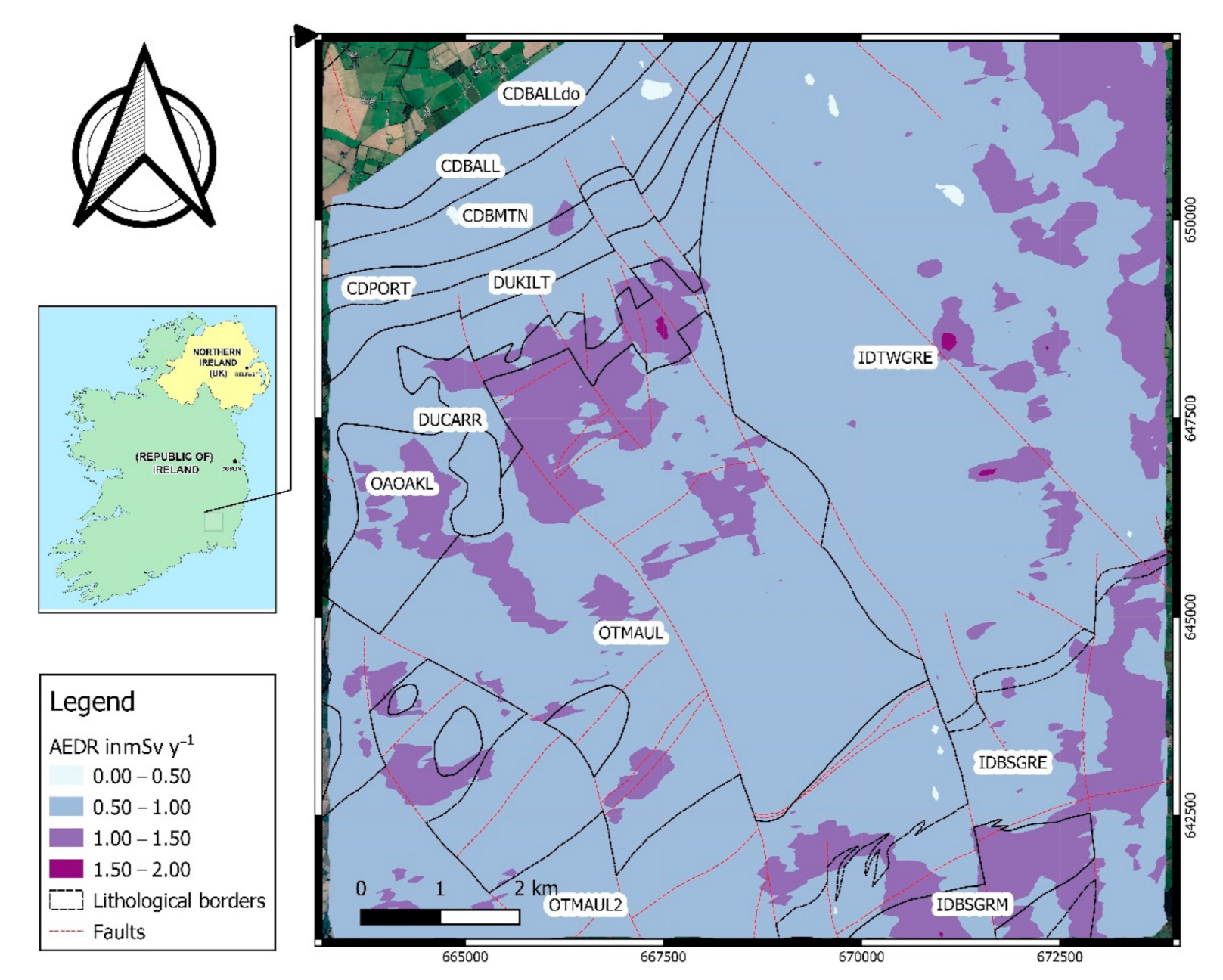
| Geology | Indoor Radon | Airborne Radiometric Data | Ambient Dose and Exhalation Rates (i.e., ADR and E) | ||||||||
|---|---|---|---|---|---|---|---|---|---|---|---|
| Bedrock Code | N. Measurements | Geometric Mean | N. Measurements | Kair | eTh | eU | ADRair (nGy h−1) | N. Measurements | ADR | E222Rn | E220Rn |
| (Bq m−3) | (%) | (mg kg−1) | (μSv h−1) | (Bq m−2 h−1) | |||||||
| CDBALL | 1348 | 50 | 127 | 2.33 | 13.47 | 5.16 | 108.73 | 3 | 0.14 | 0.91 | 1521 |
| CDBALLdo | 132 | 72 | 48 | 2.26 | 13.74 | 4.63 | 106.38 | 3 | 0.17 | 1.12 | 1460 |
| CDBMTN | 118 | 57 | 293 | 2.55 | 13.53 | 5.04 | 112.29 | 3 | 0.16 | 1.18 | 1908 |
| CDPORT | 27 | 70 | 149 | 3.38 | 15.18 | 4.88 | 130.35 | 3 | 0.22 | 0.91 | 1797 |
| DUCARR | 101 | 69 | 471 | 4.04 | 12.10 | 4.42 | 133.39 | 4 | 0.19 | 0.91 | 2038 |
| DUKILT | 158 | 76 | 214 | 3.52 | 13.74 | 4.56 | 128.32 | 3 | 0.17 | 1.02 | 2016 |
| IDBSGRE | 46 | 188 | 765 | 4.87 | 12.92 | 5.31 | 153.97 | 6 | 0.20 | 0.94 | 746 |
| IDBSGRM | 2 | 366 | 177 | 5.15 | 18.25 | 6.17 | 178.43 | 3 | 0.21 | 1.52 | 1430 |
| IDTWGRE | 312 | 117 | 3220 | 4.83 | 11.43 | 5.10 | 147.37 | 4 | 0.18 | 1.10 | 1313 |
| OAOAKL | 226 | 119 | 468 | 4.60 | 16.09 | 5.79 | 160.33 | 3 | 0.22 | 1.29 | 2187 |
| OTMAUL | 387 | 71 | 2302 | 4.24 | 16.40 | 4.85 | 148.54 | 4 | 0.18 | 0.61 | 1302 |
| OTMAUL2 | 29 | 120 | 1140 | 4.07 | 15.74 | 4.82 | 143.59 | 6 | 0.18 | 0.82 | 789 |
| Geology | Stream Sediment Geochemical Data | ||||||||||
|---|---|---|---|---|---|---|---|---|---|---|---|
| Bedrock | N. Measurements | MgO | Al2O3 | SiO2 | K2O | CaO | Fe2O3 | Y | Zr | Th | U |
| (%) | (mg kg−1) | ||||||||||
| CDBALL | 53 | 1.55 | 9.26 | 46.55 | 1.44 | 4.90 | 4.81 | 21.21 | 303.16 | 6.73 | 3.54 |
| CDBALLdo | 2 | 1.60 | 10.30 | 59.20 | 1.90 | 2.65 | 4.33 | 20.45 | 815.00 | 8.45 | 2.60 |
| CDBMTN | 5 | 1.22 | 10.52 | 59.10 | 2.29 | 1.61 | 4.01 | 22.84 | 489.86 | 8.40 | 2.74 |
| CDPORT | 1 * | 1.40 | 16.30 | 60.60 | 4.14 | 0.42 | 5.03 | 36.40 | 339.40 | 10.20 | 4.20 |
| DUCARR | 11 | 1.22 | 12.95 | 60.05 | 3.66 | 0.82 | 4.83 | 32.06 | 488.30 | 9.65 | 3.85 |
| DUKILT | 6 | 1.25 | 13.45 | 59.90 | 3.16 | 0.90 | 5.27 | 31.43 | 484.85 | 9.50 | 3.15 |
| IDBSGRE | 35 | 0.70 | 14.41 | 55.64 | 3.71 | 0.77 | 2.69 | 21.45 | 212.45 | 17.37 | 40.10 |
| IDBSGRM | 0 | - | - | - | - | - | - | - | - | - | - |
| IDTWGRE | 117 | 1.15 | 10.86 | 54.52 | 2.49 | 4.23 | 2.77 | 22.99 | 352.31 | 16.01 | 11.96 |
| OAOAKL | 104 | 1.51 | 17.91 | 57.84 | 2.89 | 0.45 | 6.73 | 30.66 | 266.38 | 10.57 | 2.89 |
| OTMAUL | 152 | 1.54 | 16.36 | 53.27 | 2.87 | 0.78 | 6.64 | 32.98 | 284.32 | 10.79 | 3.07 |
| OTMAUL2 | 23 | 1.37 | 15.18 | 56.07 | 3.25 | 0.57 | 5.73 | 32.00 | 327.55 | 9.52 | 4.28 |
| GMRn | E222Rn | eU | U | E220Rn | eTh | Th | Kair | K2O | MgO | Al2O3 | SiO2 | CaO | Fe2O3 | Y | Zr | ADR-Air | ADR | |
|---|---|---|---|---|---|---|---|---|---|---|---|---|---|---|---|---|---|---|
| GMRn | 1.00 | |||||||||||||||||
| E222Rn | 0.62 | 1.00 | ||||||||||||||||
| eU | 0.77 | 0.69 | 1.00 | |||||||||||||||
| U | 0.84 | −0.05 | 0.32 | 1.00 | ||||||||||||||
| E220Rn | −0.32 | 0.31 | −0.08 | −0.59 | 1.00 | |||||||||||||
| eTh | 0.53 | 0.25 | 0.56 | −0.35 | −0.05 | 1.00 | ||||||||||||
| Th | 0.83 | 0.01 | 0.32 | 0.82 | −0.48 | −0.33 | 1.00 | |||||||||||
| Kair | 0.67 | 0.19 | 0.50 | 0.50 | −0.28 | 0.27 | 0.79 | 1.00 | ||||||||||
| K2O | 0.40 | −0.27 | −0.14 | 0.32 | −0.03 | 0.15 | 0.40 | 0.58 | 1.00 | |||||||||
| MgO | −0.69 | −0.05 | −0.09 | −0.85 | 0.34 | 0.54 | −0.76 | −0.51 | −0.47 | 1.00 | ||||||||
| Al2O3 | 0.36 | −0.22 | 0.28 | 0.06 | 0.03 | 0.72 | 0.21 | 0.61 | 0.70 | 0.02 | 1.00 | |||||||
| SiO2 | 0.00 | 0.34 | −0.33 | −0.12 | 0.42 | 0.01 | 0.01 | 0.05 | 0.56 | −0.16 | 0.30 | 1.00 | ||||||
| CaO | −0.25 | 0.16 | 0.07 | −0.06 | −0.11 | −0.54 | −0.07 | −0.37 | −0.79 | 0.17 | −0.81 | −0.65 | 1.00 | |||||
| Fe2O3 | −0.35 | −0.24 | 0.03 | −0.64 | 0.35 | 0.84 | −0.56 | −0.02 | 0.07 | 0.70 | 0.60 | 0.02 | −0.44 | 1.00 | ||||
| Y | −0.16 | −0.39 | −0.24 | −0.39 | 0.30 | 0.56 | −0.17 | 0.31 | 0.69 | 0.24 | 0.76 | 0.40 | −0.70 | 0.68 | 1.00 | |||
| Zr | −0.47 | 0.31 | −0.60 | −0.40 | 0.27 | −0.26 | −0.43 | −0.62 | −0.34 | 0.31 | −0.51 | 0.45 | 0.16 | −0.13 | −0.26 | 1.00 | ||
| ADR-air | 0.78 | 0.32 | 0.67 | 0.42 | −0.24 | 0.53 | 0.69 | 0.95 | 0.56 | −0.36 | 0.75 | 0.03 | −0.46 | 0.18 | 0.39 | −0.69 | 1.00 | |
| ADR | 0.46 | 0.26 | 0.39 | 0.20 | 0.12 | 0.44 | 0.41 | 0.67 | 0.80 | −0.19 | 0.84 | 0.57 | −0.73 | 0.23 | 0.61 | −0.32 | 0.71 | 1.00 |
| Soil Type | Indoor Radon | Airborne Radiometric Data | Ambient Dose and Exhalation Rates | ||||||||
|---|---|---|---|---|---|---|---|---|---|---|---|
| Association | N. Measurements | Geometric Mean | N. Measurements | Kair | eTh | eU | ADRair (nGy h−1) | N. Measurements | ADR | E222Rn | E220Rn |
| (Bq m−3) | (%) | (mg kg−1) | (μSv h−1) | (Bq m−2 h−1) | |||||||
| 0410a | 1 * | 729 | 719 | 4.43 | 16.22 | 4.73 | 152.05 | 0 | - | - | - |
| 05RVI | 0 | - | 400 | 3.67 | 10.68 | 4.89 | 125.74 | 5 | 0.19 | 0.75 | 896 |
| 0660e | 5 | 296 | 141 | 5.48 | 12.99 | 5.80 | 165.41 | 0 | - | - | - |
| 0960c | 4 | 131 | 120 | 3.81 | 11.76 | 3.90 | 126.16 | 0 | - | - | - |
| 1000c | 13 | 105 | 129 | 4.63 | 11.75 | 4.46 | 140.02 | 0 | - | - | - |
| 1000x | 95 | 99 | 691 | 2.77 | 14.03 | 5.02 | 117.23 | 15 | 0.17 | 1.03 | 1740 |
| 1100a | 36 | 194 | 2673 | 4.13 | 15.89 | 4.85 | 145.22 | 3 | 0.18 | 0.71 | 1648 |
| 1100c | 4 | 105 | 892 | 4.42 | 14.94 | 5.20 | 151.12 | 6 | 0.21 | 1.07 | 2138 |
| 1100h | 76 | 304 | 3636 | 4.92 | 12.28 | 5.21 | 151.93 | 13 | 0.20 | 1.15 | 1109 |
| Urban | 16 | 319 | 89 | 3.90 | 11.19 | 4.37 | 126.43 | 3 | 0.17 | 0.79 | 706 |
| Soil Type | Stream Sediment Geochemical Data | ||||||||||
|---|---|---|---|---|---|---|---|---|---|---|---|
| Association | N. Measurements | MgO | Al2O3 | SiO2 | K2O | CaO | Fe2O3 | Y | Zr | Th | U |
| (%) | (mg kg−1) | ||||||||||
| 0410a | 1 * | 1.70 | 18.60 | 59.30 | 3.37 | 0.32 | 5.95 | 38.20 | 255.00 | 8.80 | 2.80 |
| 05RVI | 29 | 1.40 | 14.44 | 54.68 | 3.03 | 2.08 | 4.77 | 29.24 | 276.73 | 11.55 | 8.26 |
| 0660e | 2 | 0.70 | 13.90 | 55.30 | 3.73 | 1.25 | 2.23 | 26.10 | 292.15 | 33.40 | 39.05 |
| 0960c | 0 | - | - | - | - | - | - | - | - | - | - |
| 1000c | 3 | 2.20 | 8.67 | 55.17 | 2.22 | 5.17 | 1.63 | 18.37 | 386.90 | 8.53 | 5.77 |
| 1000x | 1 * | 1.40 | 16.30 | 60.60 | 4.14 | 0.42 | 5.03 | 36.40 | 339.40 | 10.20 | 4.20 |
| 1100a | 10 | 1.81 | 15.61 | 54.66 | 3.01 | 1.44 | 5.51 | 34.08 | 265.63 | 8.31 | 3.32 |
| 1100c | 1 * | 1.90 | 21.20 | 56.00 | 3.77 | 0.18 | 6.72 | 39.80 | 204.80 | 8.60 | 3.40 |
| 1100h | 8 | 1.35 | 13.55 | 52.94 | 2.99 | 2.02 | 3.91 | 26.49 | 266.73 | 12.69 | 14.91 |
| Urban | 0 | - | - | - | - | - | - | - | - | - | - |
| GMRn | E222Rn | eU | U | E220Rn | eTh | Th | Kair | K2O | MgO | Al2O3 | SiO2 | CaO | Fe2O3 | Y | Zr | Adr Air | ADR | |
|---|---|---|---|---|---|---|---|---|---|---|---|---|---|---|---|---|---|---|
| GMRn | 1.00 | |||||||||||||||||
| E222Rn | −0.20 | 1.00 | ||||||||||||||||
| eU | 0.08 | 0.73 | 1.00 | |||||||||||||||
| U | 0.05 | 0.40 | 0.82 | 1.00 | ||||||||||||||
| E220Rn | −0.93 | 0.39 | 0.62 | −0.74 | 1.00 | |||||||||||||
| eTh | 0.08 | 0.73 | 0.08 | 0.82 | 0.62 | 1.00 | ||||||||||||
| Th | 0.07 | 0.34 | 0.83 | 0.98 | −0.82 | 0.83 | 1.00 | |||||||||||
| Kair | 0.29 | 0.26 | 0.45 | 0.64 | −0.06 | 0.45 | 0.56 | 1.00 | ||||||||||
| K2O | 0.02 | 0.44 | 0.61 | 0.18 | 0.69 | 0.61 | 0.30 | −0.30 | 1.00 | |||||||||
| MgO | −0.18 | −0.20 | −0.84 | −0.83 | 0.75 | −0.84 | −0.85 | −0.22 | −0.52 | 1.00 | ||||||||
| Al2O3 | 0.25 | 0.24 | 0.23 | −0.28 | 0.88 | 0.23 | −0.19 | −0.23 | 0.71 | −0.01 | 1.00 | |||||||
| SiO2 | 0.24 | 0.14 | −0.17 | −0.32 | 0.50 | −0.17 | −0.18 | −0.58 | 0.59 | 0.04 | 0.42 | 1.00 | ||||||
| CaO | −0.31 | −0.35 | −0.47 | 0.02 | −0.93 | −0.47 | −0.09 | 0.24 | −0.88 | 0.37 | −0.91 | −0.48 | 1.00 | |||||
| Fe2O3 | 0.20 | −0.10 | −0.10 | −0.60 | 0.84 | −0.10 | −0.53 | −0.46 | 0.47 | 0.23 | 0.90 | 0.35 | −0.76 | 1.00 | ||||
| Y | 0.24 | 0.06 | 0.08 | −0.43 | 0.94 | 0.08 | −0.32 | −0.44 | 0.70 | 0.05 | 0.96 | 0.57 | −0.90 | 0.94 | 1.00 | |||
| Zr | −0.32 | −0.08 | −0.36 | 0.05 | −0.30 | −0.36 | 0.04 | −0.18 | −0.38 | 0.11 | −0.81 | 0.15 | 0.70 | −0.74 | −0.67 | 1.00 | ||
| ADR air | 0.39 | 0.35 | 0.63 | 0.56 | 0.34 | 0.63 | 0.52 | 0.91 | −0.05 | −0.23 | 0.10 | −0.39 | −0.09 | −0.17 | −0.10 | −0.42 | 1.00 | |
| ADR | −0.13 | 0.52 | 0.72 | 0.37 | 0.30 | 0.72 | 0.18 | 0.67 | −0.22 | 0.24 | 0.37 | −0.58 | 0.06 | 0.21 | −0.08 | −0.84 | 0.71 | 1.00 |
Publisher’s Note: MDPI stays neutral with regard to jurisdictional claims in published maps and institutional affiliations. |
© 2021 by the authors. Licensee MDPI, Basel, Switzerland. This article is an open access article distributed under the terms and conditions of the Creative Commons Attribution (CC BY) license (http://creativecommons.org/licenses/by/4.0/).
Share and Cite
Mousavi Aghdam, M.; Crowley, Q.; Rocha, C.; Dentoni, V.; Da Pelo, S.; Long, S.; Savatier, M. A Study of Natural Radioactivity Levels and Radon/Thoron Release Potential of Bedrock and Soil in Southeastern Ireland. Int. J. Environ. Res. Public Health 2021, 18, 2709. https://doi.org/10.3390/ijerph18052709
Mousavi Aghdam M, Crowley Q, Rocha C, Dentoni V, Da Pelo S, Long S, Savatier M. A Study of Natural Radioactivity Levels and Radon/Thoron Release Potential of Bedrock and Soil in Southeastern Ireland. International Journal of Environmental Research and Public Health. 2021; 18(5):2709. https://doi.org/10.3390/ijerph18052709
Chicago/Turabian StyleMousavi Aghdam, Mirsina, Quentin Crowley, Carlos Rocha, Valentina Dentoni, Stefania Da Pelo, Stephanie Long, and Maxime Savatier. 2021. "A Study of Natural Radioactivity Levels and Radon/Thoron Release Potential of Bedrock and Soil in Southeastern Ireland" International Journal of Environmental Research and Public Health 18, no. 5: 2709. https://doi.org/10.3390/ijerph18052709
APA StyleMousavi Aghdam, M., Crowley, Q., Rocha, C., Dentoni, V., Da Pelo, S., Long, S., & Savatier, M. (2021). A Study of Natural Radioactivity Levels and Radon/Thoron Release Potential of Bedrock and Soil in Southeastern Ireland. International Journal of Environmental Research and Public Health, 18(5), 2709. https://doi.org/10.3390/ijerph18052709








